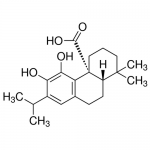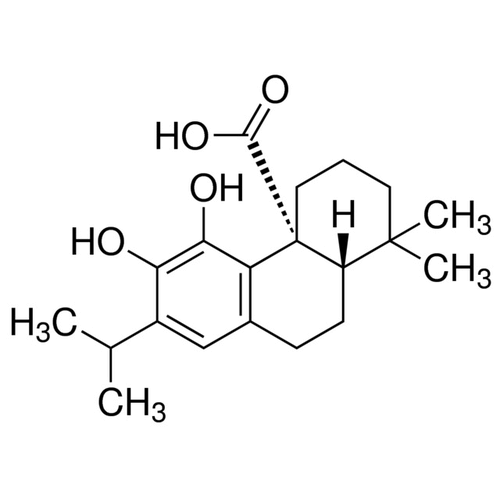| Product Name | Carnosic acid |
| Description |
PPARγ activator |
| Purity | >95% (HPLC); NMR(Conforms) |
| CAS No. | 07-09-50 |
| Molecular Formula | C20H28O4 |
| Molecular Weight | 332.43 |
| Field of Use | Not for use in humans. Not for use in diagnostics or therapeutics. For in vitro research use only. |
Properties
| Storage Temperature | -20ºC |
| Shipping Temperature | Shipped Ambient |
| Product Type | Activator |
| Solubility | Soluble in DMSO (50 mg/ml) |
| Source | Synthetic |
| Appearance | Off white to yellow solid |
| SMILES | CC(C)C1=C(C(=C2C(=C1)CC[C@@H]3[C@@]2(CCCC3(C)C)C(=O)O)O)O |
| InChI | InChI=1S/C20H28O4/c1-11(2)13-10-12-6-7-14-19(3,4)8-5-9-20(14,18(23)24)15(12)17(22)16(13)21/h10-11,14,21-22H,5-9H2,1-4H3,(H,23,24)/t14-,20+/m0/s1 |
| InChIKey | QRYRORQUOLYVBU-VBKZILBWSA-N |
| Safety Phrases |
Classification: Caution- Substance not yet fully tested. Safety Phrases: S22 - Do not breathe dust S36/37/39 - Wear suitable protective clothing, gloves and eye/face protection S24/25- Avoid contact with skin and eyes |
| Cite This Product | Carnosic acid (StressMarq Biosciences Inc., Victoria BC CANADA, Catalog # SIH-362) |
Biological Description
| Alternative Names | (4aR,10aS)-5,6-Dihydroxy-7-isopropyl-1,1-dimethyl-1,3,4,9,10,10a-hexahydro-2H-phenanthrene-4a-carboxylic acid |
| Research Areas | Apoptosis, Cancer |
| PubChem ID | 65126 |
| Scientific Background | Carnosic acid is a benzenediol abietane diterpene naturally extracted from rosemary (Rosmarinus officinalis) and sage (Saliva officinalis). It is a potent antioxidant that inhibits NADH or NADPH induced lipid peroxidation by acting as a free radical scavenger (1). It has been found to increase cellular levels of glutathione (GSH) and prevent 6-hydroxydopamine-induced cell death in SH-SY5Y cells (2). Carnosic acid-stimulation of GSH also inhibits adipocyte differentiation (3). It has also been found to induce apoptosis (4) and inhibit the proliferation and migration of various tumor cell lines (5). |
| References |
1. Schwarz K., Ternes W. (1992) Zeitschrift für Lebensmittel-Untersuchung und –Forschung. 195 (2): 99-103. 2. Chen J.H., et al. Chem. (2012) Res. Toxicol 25:1893. 3. Takahashi T., et al. (2009) Biochem. Biophys. Res. Commun. 382:549. 4. Kar S., et al. (2012) Apoptosis. 17:1735. 5. Barni M.V., et al. (2012) Oncol. Rep. 27:1041. |



Reviews
There are no reviews yet.